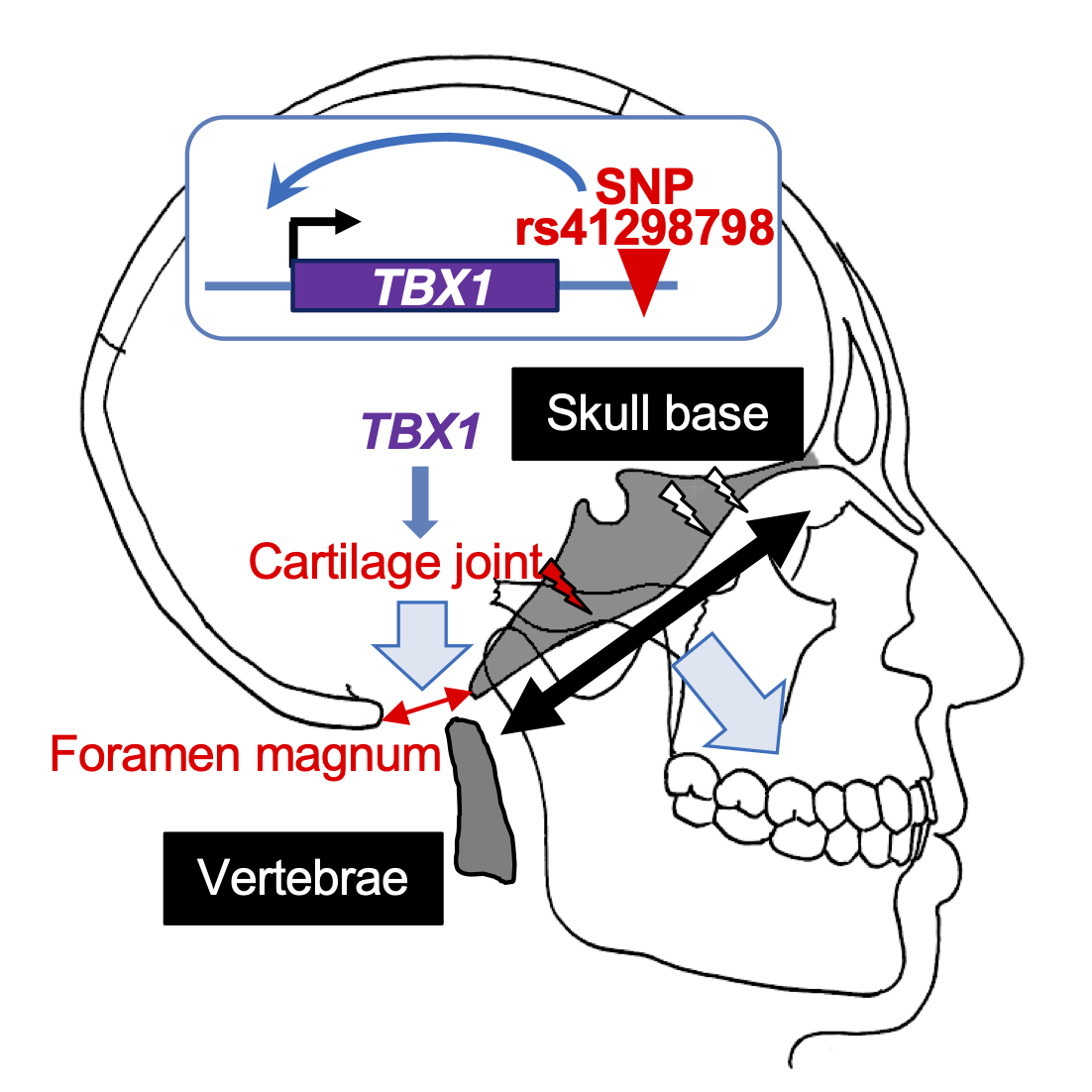Genetic Variant Identified that Shaped the Human Skull Base
April 12, 2024
Researchers from Tokyo Medical and Dental University (TMDU) and the Universities of Helsinki and Barcelona have identified a single nucleotide change key in the evolution of human skull morphology, affecting TBX1 gene expression and skull base development
Tokyo, Japan – Humans, Homo sapiens, have unique features compared with other closely related hominin species and primates, including the shape of the base of the skull. The evolutionary changes underlying these features were significant in allowing the evolution of our increased brain size. Now, in a study recently published in the American Journal of Human Genetics, a team from Tokyo Medical and Dental University (TMDU), the University of Helsinki, and the University of Barcelona has analyzed a genomic variant responsible for this unique human skull base morphology.Most of the genomic changes that occurred during human evolution did not occur directly to genes themselves, but in regions responsible for controlling and regulating the expression of genes. Variants in these same regions are often involved in genetic conditions, causing aberrant gene expression throughout development. Identifying and characterizing such genomic changes is therefore crucial for understanding human development and disease.
The development of the basicranial region, the base of the skull where it joins the bones of the neck, was key in the evolution of Homo sapiens, as we developed a highly flexed skull base that allowed our increased brain size. Therefore, variants that affect the development of this region are likely to have been highly significant in our evolution.
First, the team searched for variants in just a single letter of the DNA code, called single nucleotide polymorphisms (SNPs), that caused different regulation of genes in the basicranial region in Homo sapiens compared with other extinct hominins. One of these SNPs stood out, located in a gene called TBX1.
They then used cell lines to show that the SNP, called “rs41298798”, is located in a region that regulates the expression levels of the TBX1 gene, and that the “ancestral” form of the SNP, found in extinct hominins, is associated with lower TBX1 expression, while the form found in Homo sapiens gives us higher levels of TBX1.
“We then employed a mouse model with lower TBX1 expression,” explains lead author Noriko Funato, “which resulted in distinct alterations to the morphology at the base of the skull and premature hardening of a cartilage joint where the bones fuse together, restricting the growth ability of the skull.” The changes in the Tbx1-knockout mice were reminiscent of the known basicranial morphology of Neanderthals.
These morphological changes are also reflected in human genetic conditions associated with lower TBX1 gene dosage, such as DiGeorge syndrome and velocardiofacial syndrome, further indicating the significance of this genetic variant in the evolution of our unique skull base morphology.
The identification of this genomic variant sheds light on human evolution, as well as providing insight into common genetic conditions associated with lower expression of the TBX1 gene, paving the way for greater understanding and management of these conditions.

A regulatory variant impacting TBX1 expression contributes to the morphology at the base of the skull.
SNP, single nucleotide polymorphisms
###
The article, “A regulatory variant impacting TBX1 expression contributes to basicranial morphology in Homo sapiens”, was published in the American Journal of Human Genetics (DOI: 10.1016/j.ajhg.2024.03.012).Summary
Researchers from Tokyo Medical and Dental University (TMDU) and the Universities of Helsinki and Barcelona have identified a variant in the gene TBX1 as key in the development of the unique morphology at the base of the skull. TBX1 is present at higher levels in humans than in closely related hominins. Low TBX1 also occurs in certain genetic conditions causing altered skull base morphology. This study provides a greater understanding of human disease and evolution.
Journal Article
JOURNAL: The American Journal of Human Genetics
TITLE: A regulatory variant impacting TBX1 expression contributes to basicranial morphology in Homo sapiens
DOI: https://doi.org/10.1016/j.ajhg.2024.03.012
TITLE: A regulatory variant impacting TBX1 expression contributes to basicranial morphology in Homo sapiens
DOI: https://doi.org/10.1016/j.ajhg.2024.03.012
Correspondence to
Noriko Funato, Associate Professor
Department of Signal Gene Regulation,
Graduate School of Medical and Dental Sciences,
Tokyo Medical and Dental University(TMDU)
E-mail:noriko-funato(at)umin.ac.jp
*Please change (at) in e-mail addresses to @ on sending your e-mail to contact personnels.

